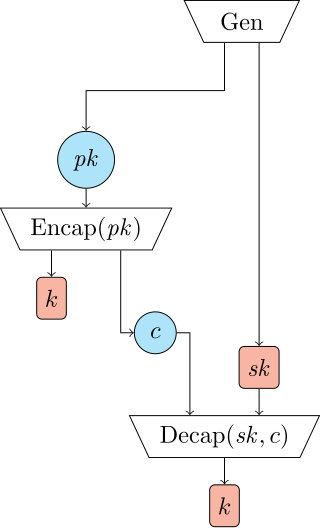In cryptography, a block cipher is a deterministic algorithm that operates on fixed-length groups of bits, called blocks. Block ciphers are the elementary building blocks of many cryptographic protocols. They are ubiquitous in the storage and exchange of data, where such data is secured and authenticated via encryption.
Differential cryptanalysis is a general form of cryptanalysis applicable primarily to block ciphers, but also to stream ciphers and cryptographic hash functions. In the broadest sense, it is the study of how differences in information input can affect the resultant difference at the output. In the case of a block cipher, it refers to a set of techniques for tracing differences through the network of transformation, discovering where the cipher exhibits non-random behavior, and exploiting such properties to recover the secret key.
In cryptography, linear cryptanalysis is a general form of cryptanalysis based on finding affine approximations to the action of a cipher. Attacks have been developed for block ciphers and stream ciphers. Linear cryptanalysis is one of the two most widely used attacks on block ciphers; the other being differential cryptanalysis.

The Vigenère cipher is a method of encrypting alphabetic text where each letter of the plaintext is encoded with a different Caesar cipher, whose increment is determined by the corresponding letter of another text, the key.
Malleability is a property of some cryptographic algorithms. An encryption algorithm is "malleable" if it is possible to transform a ciphertext into another ciphertext which decrypts to a related plaintext. That is, given an encryption of a plaintext , it is possible to generate another ciphertext which decrypts to , for a known function , without necessarily knowing or learning .

In cryptography, a block cipher mode of operation is an algorithm that uses a block cipher to provide information security such as confidentiality or authenticity. A block cipher by itself is only suitable for the secure cryptographic transformation of one fixed-length group of bits called a block. A mode of operation describes how to repeatedly apply a cipher's single-block operation to securely transform amounts of data larger than a block.

In cryptography, ciphertext or cyphertext is the result of encryption performed on plaintext using an algorithm, called a cipher. Ciphertext is also known as encrypted or encoded information because it contains a form of the original plaintext that is unreadable by a human or computer without the proper cipher to decrypt it. This process prevents the loss of sensitive information via hacking. Decryption, the inverse of encryption, is the process of turning ciphertext into readable plaintext. Ciphertext is not to be confused with codetext because the latter is a result of a code, not a cipher.
The meet-in-the-middle attack (MITM), a known plaintext attack, is a generic space–time tradeoff cryptographic attack against encryption schemes that rely on performing multiple encryption operations in sequence. The MITM attack is the primary reason why Double DES is not used and why a Triple DES key (168-bit) can be brute-forced by an attacker with 256 space and 2112 operations.
The NTRUEncrypt public key cryptosystem, also known as the NTRU encryption algorithm, is an NTRU lattice-based alternative to RSA and elliptic curve cryptography (ECC) and is based on the shortest vector problem in a lattice.
In cryptography, a classical cipher is a type of cipher that was used historically but for the most part, has fallen into disuse. In contrast to modern cryptographic algorithms, most classical ciphers can be practically computed and solved by hand. However, they are also usually very simple to break with modern technology. The term includes the simple systems used since Greek and Roman times, the elaborate Renaissance ciphers, World War II cryptography such as the Enigma machine and beyond.

The rail fence cipher is a classical type of transposition cipher. It derives its name from the manner in which encryption is performed, in analogy to a fence built with horizontal rails.
The four-square cipher is a manual symmetric encryption technique. It was invented by the French cryptographer Felix Delastelle.
The Two-square cipher, also called double Playfair, is a manual symmetric encryption technique. It was developed to ease the cumbersome nature of the large encryption/decryption matrix used in the four-square cipher while still being slightly stronger than the single-square Playfair cipher.
The slide attack is a form of cryptanalysis designed to deal with the prevailing idea that even weak ciphers can become very strong by increasing the number of rounds, which can ward off a differential attack. The slide attack works in such a way as to make the number of rounds in a cipher irrelevant. Rather than looking at the data-randomizing aspects of the block cipher, the slide attack works by analyzing the key schedule and exploiting weaknesses in it to break the cipher. The most common one is the keys repeating in a cyclic manner.
Disk encryption is a special case of data at rest protection when the storage medium is a sector-addressable device. This article presents cryptographic aspects of the problem. For an overview, see disk encryption. For discussion of different software packages and hardware devices devoted to this problem, see disk encryption software and disk encryption hardware.

In cryptography, a one-way compression function is a function that transforms two fixed-length inputs into a fixed-length output. The transformation is "one-way", meaning that it is difficult given a particular output to compute inputs which compress to that output. One-way compression functions are not related to conventional data compression algorithms, which instead can be inverted exactly or approximately to the original data.
In cryptography, Galois/Counter Mode (GCM) is a mode of operation for symmetric-key cryptographic block ciphers which is widely adopted for its performance. GCM throughput rates for state-of-the-art, high-speed communication channels can be achieved with inexpensive hardware resources.

In cryptography, a key encapsulation mechanism, or KEM, is a public-key cryptosystem that allows a sender to generate a short secret key and transmit it to a receiver securely, in spite of eavesdropping and intercepting adversaries.
ACE is the collection of units, implementing both a public key encryption scheme and a digital signature scheme. Corresponding names for these schemes — «ACE Encrypt» and «ACE Sign». Schemes are based on Cramer-Shoup public key encryption scheme and Cramer-Shoup signature scheme. Introduced variants of these schemes are intended to achieve a good balance between performance and security of the whole encryption system.
HEAAN is an open source homomorphic encryption (HE) library which implements an approximate HE scheme proposed by Cheon, Kim, Kim and Song (CKKS). The first version of HEAAN was published on GitHub on 15 May 2016, and later a new version of HEAAN with a bootstrapping algorithm was released. Currently, the latest version is Version 2.1.

































































